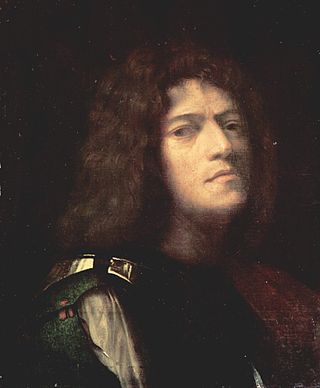
Giorgione was an Italian painter of the Venetian school during the High Renaissance, who died in his thirties. He is known for the elusive poetic quality of his work, though only about six surviving paintings are firmly attributed to him. The uncertainty surrounding the identity and meaning of his work has made Giorgione one of the most mysterious figures in European art.

Tiziano Vecelli or Vecellio, known in English as Titian, was an Italian (Venetian) painter of the Renaissance, considered the most important member of the 16th-century Venetian school. He was born in Pieve di Cadore, near Belluno. During his lifetime he was often called da Cadore, 'from Cadore', taken from his native region.

Paolo Caliari, known as Paolo Veronese, was an Italian Renaissance painter based in Venice, known for extremely large history paintings of religion and mythology, such as The Wedding at Cana (1563) and The Feast in the House of Levi (1573). Included with Titian, a generation older, and Tintoretto, a decade senior, Veronese is one of the "great trio that dominated Venetian painting of the cinquecento" and the Late Renaissance in the 16th century. Known as a supreme colorist, and after an early period with Mannerism, Paolo Veronese developed a naturalist style of painting, influenced by Titian.

Giovanni di Niccolò de Luteri, better known as Dosso Dossi, was an Italian Renaissance painter who belonged to the School of Ferrara, painting in a style mainly influenced by Venetian painting, in particular Giorgione and early Titian.

Giovanni Battista Moroni was an Italian painter of the Late Renaissance period. He also is called Giambattista Moroni. Best known for his elegantly realistic portraits of the local nobility and clergy, he is considered one of the great portrait painters of the Cinquecento.

The Venus of Urbino is an oil painting by the Italian painter Titian, which seems to have been begun in 1532 or 1534, and was perhaps completed in 1534, but not sold until 1538. It depicts a nude young woman, traditionally identified with the goddess Venus, reclining on a couch or bed in the sumptuous surroundings of a Renaissance palace. It is now in the Galleria degli Uffizi in Florence.

Portrait of Baldassare Castiglione is a c. 1514–1515 oil painting attributed to the Italian High Renaissance painter Raphael. Considered one of the great portraits of the Renaissance, it has an enduring influence. It depicts Raphael's friend, the diplomat and humanist Baldassare Castiglione, who is considered a quintessential example of the High Renaissance gentleman.
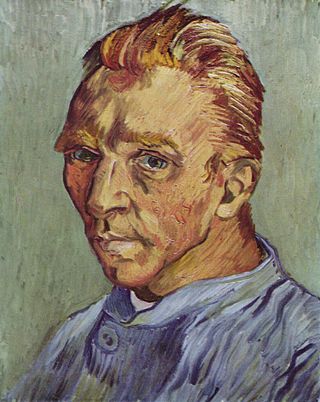
A self-portrait is a portrait of an artist made by that artist. Although self-portraits have been made since the earliest times, it is not until the Early Renaissance in the mid-15th century that artists can be frequently identified depicting themselves as either the main subject, or as important characters in their work. With better and cheaper mirrors, and the advent of the panel portrait, many painters, sculptors and printmakers tried some form of self-portraiture. Portrait of a Man in a Turban by Jan van Eyck of 1433 may well be the earliest known panel self-portrait. He painted a separate portrait of his wife, and he belonged to the social group that had begun to commission portraits, already more common among wealthy Netherlanders than south of the Alps. The genre is venerable, but not until the Renaissance, with increased wealth and interest in the individual as a subject, did it become truly popular.

Pope Paul III and His Grandsons is a painting in oil on canvas by Titian, housed in the Museo di Capodimonte, Naples. It was commissioned by the Farnese family and painted during Titian's visit to Rome between autumn 1545 and June 1546. It depicts the scabrous relationship between Pope Paul III and his grandsons, Ottavio and Alessandro Farnese. Ottavio is shown in the act of kneeling, to his left; Alessandro, wearing a cardinal's dress, stands behind him to his right. The painting explores the effects of ageing and the manoeuvring behind succession; Paul was at the time in his late seventies and ruling in an uncertain political climate as Charles V, Holy Roman Emperor came into ascendancy.

The Allegory of Prudence is an oil-on-canvas painting attributed to the Italian artist Titian and his assistants. The painting portrays three human heads, each facing in a different direction, above three animal heads. It is in the National Gallery, London.

Charles IV in his Hunting Clothes is an oil on canvas painting of 1799 by the Spanish artist Francisco Goya, the second of his two portraits of King Charles IV of Spain.

The Venetian painter Titian and his workshop made at least six versions of the same composition showing Danaë, painted between about 1544 and the 1560s. The scene is based on the mythological princess Danaë, as – very briefly – recounted by the Roman poet Ovid, and at greater length by Boccaccio. She was isolated in a bronze tower following a prophecy that her firstborn would eventually kill her father. Although aware of the consequences, Danaë was seduced and became pregnant by Zeus, who, inflamed by lust, descended from Mount Olympus to seduce her in the form of a shower of gold.

The Worship of Venus is an oil on canvas painting by the Italian artist Titian completed between 1518 and 1519, housed at the Museo del Prado in Madrid, Spain. It describes a Roman rite of worship conducted in honour of the goddess Venus each 1 April. On this occasion, women would make offerings to representations of the goddess so as to cleanse "every blemish on their bodies".
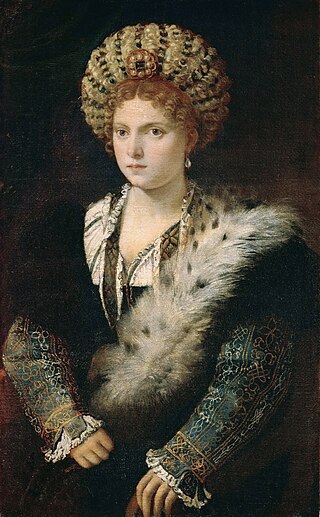
Isabella in Black is a portrait of a young woman by Titian. It can be dated to the 1530s and is in the Kunsthistorisches Museum in Vienna. The artist and the date are undisputed. Beyond the museum documentation, there are repeated doubts about the person depicted.

Equestrian Portrait of Charles V is an oil-on-canvas painting by the Italian Renaissance artist Titian. Created between April and September 1548 while Titian was at the imperial court of Augsburg, it is a tribute to Charles V, Holy Roman Emperor, following his victory in the April 1547 Battle of Mühlberg against the Protestant armies.

A Man with a Quilted Sleeve is a painting of about 1510 by the Venetian painter Titian in the National Gallery, London, measuring 81.2 by 66.3 centimetres. Though the quality of the painting has always been praised, there has been much discussion as to the identity of the sitter. It was long thought to be a portrait of Ariosto, then a self-portrait, but in 2017 is called Portrait of Gerolamo (?) Barbarigo by the gallery, having also been called merely Portrait of a Man, the title used here, The Man with the Blue Sleeve, and no doubt other variants.
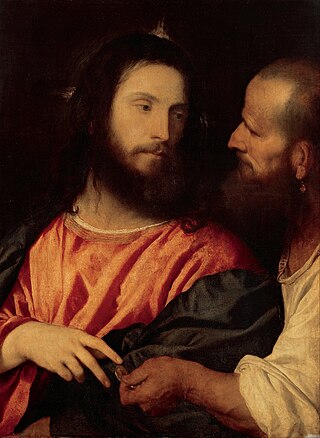
The Tribute Money is a panel painting in oils of 1516 by the Italian late Renaissance artist Titian, now in the Gemäldegalerie Alte Meister in Dresden, Germany. It depicts Christ and a Pharisee at the moment in the Gospels when Christ is shown a coin and says "Render unto Caesar the things that are Caesar's, and unto God the things that are God's". It is signed "Ticianus F.[ecit]", painted on the trim of the left side of the Pharisee's collar.

The Portrait of Isabella of Portugal is an oil-on-canvas portrait of Isabella of Portugal, Holy Roman Empress by Titian dating to 1548. It was part of the Spanish royal collection and is now in the Museo del Prado in Madrid.
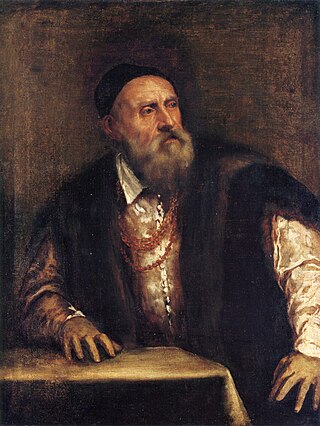
Self-Portrait is an oil on canvas self-portrait by the Venetian painter Titian, dated c. 1546–47. While he painted a number of independent self-portraits in various formats, this is one of only two painted examples to survive. The other is in Madrid, dated c. 1560. Both share a somber and reserved palette, although this example is richer in tonal variation and colour harmonisation.

The Family of Darius before Alexander is an oil painting on canvas by Paolo Veronese, created ca. 1565–1570. It depicts Alexander the Great with the family of Darius III, the Persian king he had defeated in battle. Although Veronese had previously painted a version of the subject, since destroyed, the theme had rarely been depicted by other artists before him. The painting has been in the collection of the National Gallery in London since 1857.





















